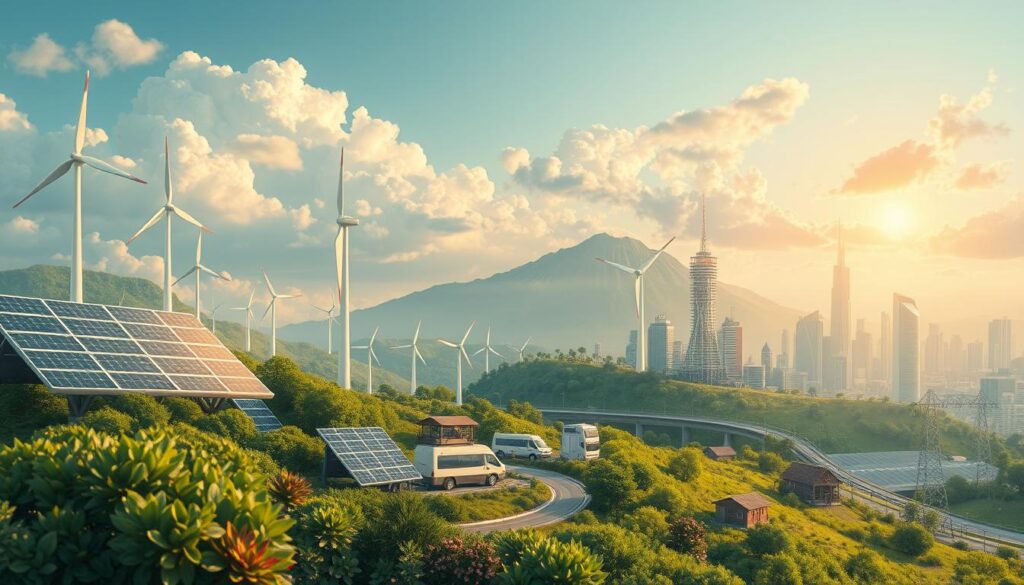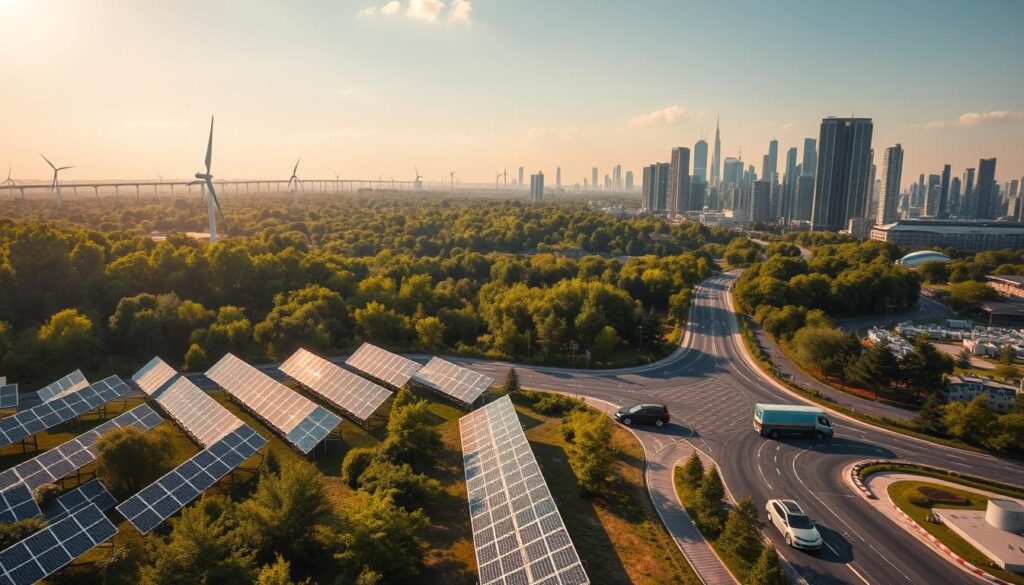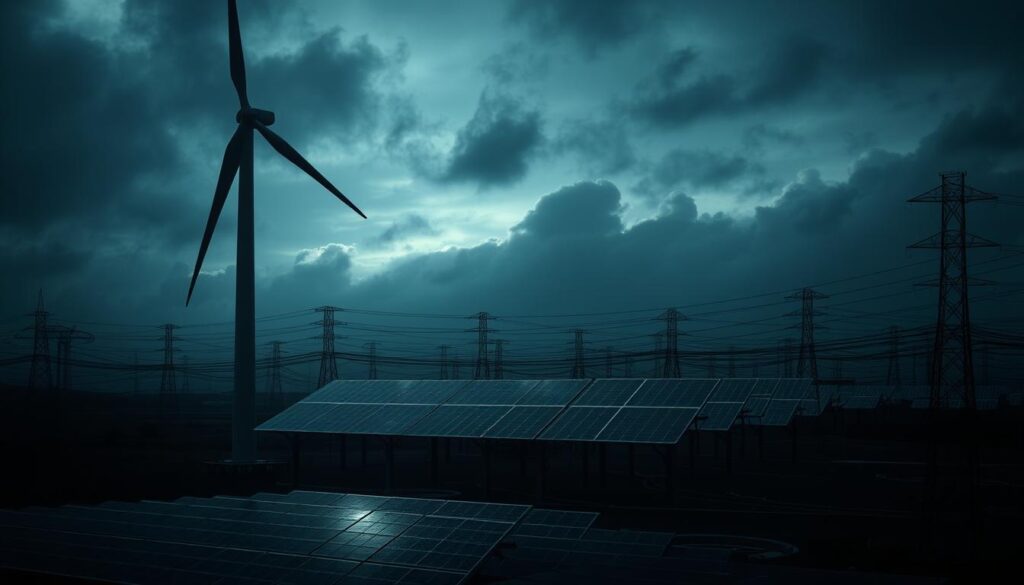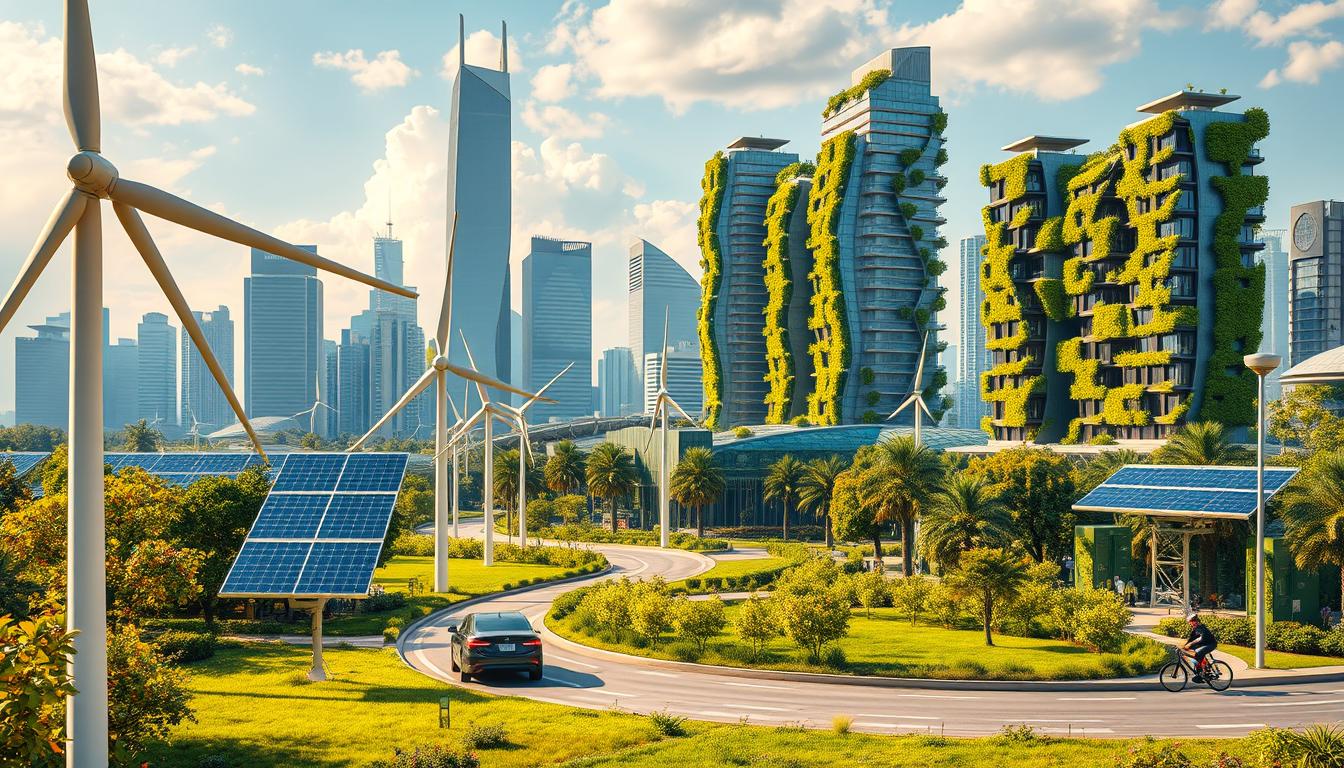In today’s world, the need for sustainable solutions has never been more urgent. Innovations in environmentally friendly practices are transforming industries and reducing our impact on the planet. These advancements, often referred to as green technology, are paving the way for a cleaner, healthier future.
From renewable energy sources like solar and wind to smarter waste management systems, these technologies are addressing critical challenges. They not only help combat climate change but also create new opportunities for economic growth and job creation.

One of the most significant breakthroughs is in energy storage, which enhances the reliability of clean power systems. Additionally, the rise of electric vehicles and smart cities demonstrates how technology can drive sustainability on a global scale.
Key Takeaways
- Green technology reduces pollution and supports a healthier environment.
- Renewable energy sources like solar and wind are key to clean power solutions.
- Electric vehicles and smart cities are driving sustainability globally.
- Energy storage advancements improve the reliability of renewable systems.
- These innovations create jobs and boost economic growth.
What Is Green Technology?
The push for eco-friendly solutions has gained momentum in recent years. These advancements aim to reduce our environmental impact while promoting sustainability. By leveraging science and innovation, they address critical challenges like pollution and resource depletion.
Defining the Core Concept
Green technology refers to innovations designed to minimize harm to the environment. It encompasses a wide range of processes and products, from renewable energy sources to efficient waste management systems. These solutions aim to protect natural resources and repair past environmental damage.
Green Tech vs. Clean Tech vs. Environmental Tech
While these terms are often used interchangeably, they have distinct focuses. Green tech is a broad category that includes technologies like solar power and electric vehicles. Clean tech emphasizes efficiency and cost reduction alongside environmental benefits. Environmental tech targets large-scale infrastructure, such as water treatment plants and air filtration systems.
| Type | Focus | Examples |
|---|---|---|
| Green Tech | Minimizing environmental harm | Solar panels, electric vehicles |
| Clean Tech | Efficiency and cost reduction | Energy-efficient engines, alternative fuels |
| Environmental Tech | Large-scale infrastructure | Water treatment plants, air filtration systems |
These technologies not only benefit the planet but also offer financial savings and economic gains for companies. By adopting these practices, businesses can enhance their reputation while contributing to a healthier future.
The Evolution of Green Technology

The journey toward sustainable practices has deep historical roots. Early efforts to address environmental challenges emerged in response to crises like the Dust Bowl and industrial pollution. These events highlighted the urgent need to protect our natural resources and reduce harmful impacts on the climate.
From the Dust Bowl to Modern Innovations
The Dust Bowl of the 1930s was a turning point in environmental awareness. It led to the Soil Conservation Act of 1935, one of the earliest federal efforts to combat soil erosion and promote sustainable land use. During World War II, recycling programs emphasized the importance of resource conservation, laying the groundwork for modern technology solutions.
In recent decades, the shift from fossil fuels to renewable energy sources has been a cornerstone of progress. Innovations in solar, wind, and biofuels have transformed the industry, offering cleaner alternatives to traditional power systems.
Key Milestones in Environmental Policy
The establishment of the EPA in 1970 marked a pivotal moment in environmental protection. It introduced pollution controls and mandated the development of clean technologies, setting a new standard for sustainability.
Modern policies, like the Infrastructure Investment and Jobs Act of 2021, reflect a renewed commitment to eco-friendly solutions. This legislation allocated $1.2 trillion to support clean energy and electric vehicle infrastructure, addressing both environmental and economic needs.
| Year | Milestone | Impact |
|---|---|---|
| 1935 | Soil Conservation Act | Combated soil erosion and promoted sustainable land use |
| 1970 | EPA Establishment | Introduced pollution controls and clean tech mandates |
| 2021 | Infrastructure Investment and Jobs Act | Funded clean energy and EV infrastructure |
Public awareness and activism have also played a crucial role in driving these advancements. Campaigns and educational initiatives have inspired individuals and businesses to adopt sustainable practices, ensuring a healthier world for future generations.
Types of Green Technology Driving Change
Innovations in sustainable practices are reshaping industries worldwide. From cleaner energy sources to smarter infrastructure, these advancements are addressing critical environmental challenges. Let’s explore the key areas where these solutions are making a significant impact.
Renewable Energy: Solar, Wind, and Beyond
Solar panels and wind power are leading the transition to cleaner energy systems. Solar panels have become more efficient, with improvements of over 20% in recent years. Wind turbines are also evolving, with designs that work even in low-wind conditions.
These renewable energy sources accounted for 71% of new power capacity in 2024. Additionally, innovations like hydrogen fuel and carbon capture are emerging as promising alternatives for a sustainable future.
Sustainable Transportation: EVs and Smart Infrastructure
Electric vehicles (EVs) are reducing greenhouse gas emissions, though their effectiveness depends on the energy grid’s carbon intensity. Smart infrastructure, including charging stations and energy-efficient grids, supports this transition.
EVs are not just about cleaner transportation. They also integrate with smart systems to optimize power usage and reduce overall environmental impact.
Waste Management and the Circular Economy
Advanced waste management systems are transforming how we handle resources. Waste-to-energy technologies convert organic materials into biogas, reducing landfill dependency. Innovations like biodegradable polymers and recyclable adhesives also minimize electronic waste.
The circular economy focuses on reusing materials in production cycles, promoting resource efficiency. Companies are adopting zero-waste processes to align with this model.
The Environmental Impact of Green Tech

The shift toward eco-conscious solutions is transforming how we interact with our environment. These advancements are not only reducing our carbon footprint but also preserving vital natural resources. By focusing on cleaner energy and smarter systems, we’re making strides toward a healthier planet.
Reducing Carbon Emissions
One of the most significant benefits of sustainable practices is the reduction of carbon emissions. Solar panels and wind turbines are replacing fossil fuels, cutting down on harmful gases released into the atmosphere. For example, solar power alone can reduce CO2 emissions by up to 37 gigawatts annually.
Electric vehicles are another game-changer. They produce fewer emissions compared to traditional cars, especially when powered by renewable energy. This shift is crucial for combating climate change and improving air quality.
Conserving Natural Resources
Sustainable practices are also helping conserve natural resources. Vertical farming, for instance, uses less water and soil, making agriculture more efficient. This approach reduces strain on ecosystems and promotes long-term sustainability.
Energy-efficient technologies, like LED lighting, further decrease resource consumption. These innovations not only save energy but also lower utility bills, making them a win-win for both the environment and consumers.
By adopting these solutions, we’re not just protecting the planet—we’re ensuring a healthier future for generations to come.
Challenges and Ethical Considerations

While sustainable innovations promise a brighter future, they also bring significant challenges. High upfront costs and inadequate infrastructure often slow the adoption of eco-friendly solutions. For example, insufficient charging stations limit the growth of electric vehicles, making it harder for consumers to transition.
Supply chain shortages further complicate the situation. The extraction of rare minerals, like lithium for EV batteries, often leads to environmental damage and human rights abuses in mining regions. These ethical dilemmas highlight the need for responsible sourcing and fair labor practices.
Biofuel production, while a cleaner alternative to fossil fuels, also raises concerns. Its environmental impact, including deforestation and water usage, must be carefully managed to avoid unintended harm to ecosystems.
Social equity is another critical issue. Low-income communities and developing countries face barriers in accessing these advancements due to high costs and limited resources. Ensuring fair access is essential for a truly sustainable future.
Balancing environmental benefits with potential harm is a delicate task. While these innovations aim to reduce carbon emissions and conserve resources, their long-term impact on ecosystems and communities must be carefully evaluated.
By addressing these challenges and ethical considerations, we can create a more inclusive and responsible path toward sustainability.
The Role of Government Policies
Government policies play a pivotal role in shaping the future of sustainable innovations. By offering incentives and setting mandates, they accelerate the adoption of eco-friendly solutions. For instance, the U.S. Infrastructure Investment and Jobs Act allocated $1.2 trillion to support clean energy and electric vehicle infrastructure.
Tax credits and subsidies are powerful tools to encourage companies to invest in renewable energy projects. These incentives reduce upfront costs, making it easier for businesses to transition to cleaner technology.
Renewable energy mandates ensure long-term commitments to sustainability. Countries like Norway have implemented robust policies that promote the use of solar and wind power, setting an example for others to follow.
International collaborations, such as the Paris Agreement, set global standards for reducing pollution and combating climate change. These agreements encourage countries to adopt sustainable practices and share innovative solutions.
However, policies must address disparities in access to eco-friendly solutions. Low-income regions often face barriers due to high costs and limited resources. Ensuring equitable distribution of technology is essential for a fair transition.
Public-private partnerships can bridge funding gaps for large-scale projects. The Netherlands’ Energy Agreement for Sustainable Growth is a prime example, involving collaboration between government, industry, and NGOs to drive innovation.
| Policy | Impact |
|---|---|
| U.S. Infrastructure Act | Funded clean energy and EV infrastructure |
| Norway’s Renewable Mandates | Promoted solar and wind power adoption |
| Paris Agreement | Set global standards for sustainability |
| Netherlands’ Energy Agreement | Fostered public-private collaboration |
By reforming public procurement and setting green criteria for contracts, governments can encourage sustainable consumption and production practices. Training public procurers in sustainable management further enhances these efforts.
These policies not only drive innovation but also create jobs and revitalize local economies. The UK’s Humber region, for example, transformed into a hub for offshore wind power, demonstrating the potential of just transitions.
Government actions are crucial for building a sustainable future. By addressing challenges and fostering collaboration, they pave the way for a healthier planet and equitable access to eco-friendly solutions.
How Businesses and Individuals Can Adopt Green Tech
Adopting eco-friendly practices is no longer just a trend—it’s a necessity for businesses and individuals alike. From reducing emissions to conserving resources, small changes can lead to significant environmental benefits. Let’s explore actionable steps to embrace sustainable solutions.
Tracking Carbon Footprints
Businesses can use carbon accounting tools to measure and reduce their environmental impact. For example, cloud computing and virtualization help lower energy consumption, making operations more efficient. These tools provide insights into areas where improvements can be made, such as upgrading to energy-efficient facilities.
Individuals can also play a role by adopting energy-efficient appliances and reducing single-use plastics. Simple changes, like using smart thermostats, contribute to cost savings and eco-friendly branding.
Investing in Sustainable Solutions
Investing in green technology stocks or mutual funds supports industry growth and innovation. Businesses can benefit from tax incentives and rebates when they invest in renewable energy systems. These investments not only promote sustainability but also ensure long-term financial gains.
Zero-waste initiatives and recycling programs are another way to minimize environmental impact. Establishing internal equipment recycling programs helps reduce waste and promotes resource reuse.
| Action | Impact |
|---|---|
| Use carbon tracking tools | Reduces emissions and improves efficiency |
| Invest in green tech stocks | Supports sustainable innovation |
| Adopt energy-efficient appliances | Lowers energy consumption and costs |
| Implement recycling programs | Minimizes waste and conserves resources |
By taking these steps, businesses and individuals can contribute to a healthier planet while reaping financial and operational benefits. The journey toward sustainability starts with small, actionable changes that add up over time.
Conclusion
As we move forward, the importance of sustainable innovations becomes increasingly clear. These advancements are essential for reducing carbon emissions and preserving our planet’s natural resources. From renewable energy systems to smarter infrastructure, they offer practical solutions to pressing environmental challenges.
Widespread adoption of these practices depends on innovation, investment, and collaboration. Governments, businesses, and individuals all play a role in driving this transition. By embracing these changes, we can create a healthier world for future generations.
While challenges like high costs and technical limitations exist, the benefits far outweigh the obstacles. Sustainable practices not only protect the climate but also foster economic growth and job creation. Together, we can build a future where sustainability is at the core of every decision.
FAQ
What is the difference between green tech, clean tech, and environmental tech?
Green tech focuses on reducing environmental impact through innovations like solar panels and wind power. Clean tech aims to improve efficiency and reduce pollution across industries. Environmental tech addresses specific ecological issues, such as water conservation and waste management.
How does renewable energy contribute to sustainability?
Renewable energy sources like solar and wind power reduce reliance on fossil fuels, lower greenhouse gas emissions, and help conserve natural resources. They play a key role in creating a more sustainable future.
What are some examples of sustainable transportation?
Electric vehicles (EVs), public transit systems, and smart infrastructure like bike-sharing programs are examples of sustainable transportation. These solutions reduce carbon emissions and promote cleaner air.
How can businesses reduce their carbon footprint?
Businesses can track their energy consumption, invest in renewable energy, adopt recycling practices, and implement energy-efficient technologies. These steps help minimize their environmental impact.
What role do government policies play in green tech adoption?
Governments can incentivize green tech through subsidies, tax breaks, and regulations that encourage companies and individuals to adopt sustainable practices. Policies also drive innovation in renewable energy and waste management.
What challenges does green tech face?
Challenges include high initial costs, limited infrastructure, and the need for widespread adoption. Ethical considerations, such as ensuring fair access to these technologies, also play a role.
How can individuals contribute to a sustainable future?
Individuals can reduce energy consumption, recycle, use public transportation, and support companies that prioritize sustainability. Small changes in daily habits can have a big impact.
